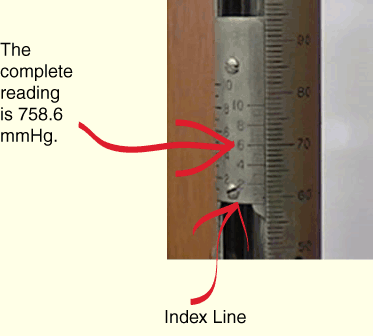 |
|
Reading a Mercury Barometer |
|||||||||
 |
The mercury barometer is located on the wall in the balance room between each laboratory. | ||||||||
|
In the very bottom of the barometer is a pool of Mercury, which supplies the column with Mercury. |
 |
||||||||
 |
Notice that the Mercury meniscus, concave down, is opposite of water, which is concave up. When reading pressure on the barometer the top of the meniscus needs to be level with the index line, which extends from the bottom of the sliding metal plate. Adjust the knob on the side until the bottom of the sliding metal plate sits atop the Mercury meniscus. |  |
|||||||
 |
After the sliding metal plate is lined up with the meniscus, it is time to take a reading. Notice that the index line is lined up in between 700 mmHg and 800 mmHg. | ||||||||
 |
|||||||||
| A closer look shows that the index line is between 758 and 759, so our pressure measures 758.X mmHg. Use the Vernier scale to find out how many tenths of a mmHg are in the measurement by finding the line on the Vernier that lines up exactly with a line on the main scale. In this case the 6 on the Vernier scale lines up exactly with the main scale, so the complete reading is 758.6 mmHg. | |||||||||